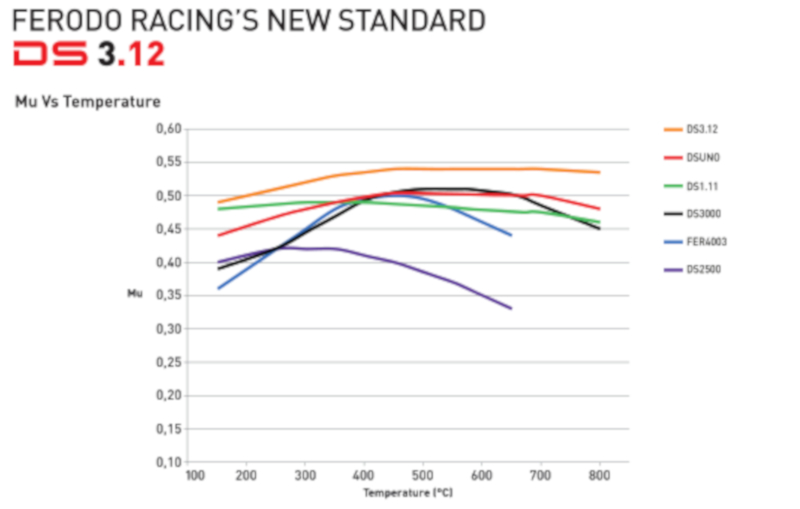Some input on the Ferodo DS compounds with regards to front/rear, and some overall notes on mixed mu pad setups.
Our recommendation on this chassis (and just about all chassis for which we develop brake systems) is to the run the same pad compound front and rear for superior performance and longevity. We design, run calculations, run simulations, conduct testing, etc. with the assumption of the same brake pad compound front and rear. Any deviation from that is going to impact brake bias. Any time you run a higher mu pad on one end of the car, you're shifting some amount of brake work to that end of the car. In the case of this thread, the DS1.11 is a higher mu pad than the DS2500, so you're shifting bias towards the front when you run 1.11 front/2500 rear.
The relevant question here is, "Is that bias difference enough to be problematic?"
We have quite a few customers across different platforms running the DS1.11 up front and DS2500 in the rear. As noted by others, this is mostly born out of the convenience of only having to swap one axle of pads. For the casual HPDE enthusiast, our experience tells us that leaving the DS2500 in the rear tends to NOT be problematic on BMW M cars. It's not ideal, but it doesn't create any major issues. Just keep in mind though, that when you're running DS1.11 front and DS2500 rear, you're shifting a little bit of brake bias to the front of the car. That is going to put more strain and wear and tear on the front brakes. Having the same pad compound at both ends of the car will use the brakes at both ends of the car most efficiently.
To some people, the convenience factor is worth the trade-off in performance and wear. Some things below to watch out for however:
- If you are running a higher mu front pad and are seeing more pad wear on the front than you'd like, switch to the same compound front and rear.
- If you are running a higher mu front pad and are not getting the life out of your front discs that you want, or are boiling brake fluid, swap to the same compound front and rear.
- If you are trying to squeeze every tenth of a second out of your car, particularly on race tires, run the same compound front and rear.
- If you are having any type of ABS funkiness or early ABS intervention up front, run the same pad compound front and rear.
In some cases we've actually had people tune their brakes in the opposite manner via a higher mu rear pad compound. For example, we had one Subaru STI time attack gent run a slightly higher mu pad in the rear to try and get the car to rotate more under trail-braking. However, that would be much more of a problem on a nose-heavy pig, excuse me platform, such as the STI than it would on a beautifully balanced M2.

Also of note, if you are running a more aggressive Ferodo compound like the new DS3.12 on the front, we definitely would NOT suggest running the DS2500 on the rear. Running the DS3.12 front and DS1.11 rear would likely be okay, as the difference in mu between those is not as great. The gap in mu between the DS3.12 and DS1.11 is considerable however, and more than we'd suggest running. That setup isn't going to give you the results you want.
Below is a mu graph from Ferodo that shows the relative difference in mu curves across their pad compounds. Don't worry about the specific mu numbers. Trying to compare mu values on this chart with numbers provided by other pad brands is no different than trying to compare horsepower numbers from a Dynojet vs. a Mustang Dyno. This graph is really only useful for comparing mu curves within the Ferodo pad lineup. You'll see that the DS1.11 and DS2500 have fairly similar shapes to their mu curves up to about 900 degrees F (500C). At that point, you'll see a steady drop-off in the DS2500's mu, whereas the DS1.11 declines more slowly. The hotter you get 'em, the greater the difference you'll see in the ability of the DS1.11 and DS2500 to generate friction. In other words, if you're running your brakes super hot on a tough braking track, the spread between how much friction the pads are generating at the front vs. the rear of the car is going to widen.

Hopefully the above is helpful and makes sense.
